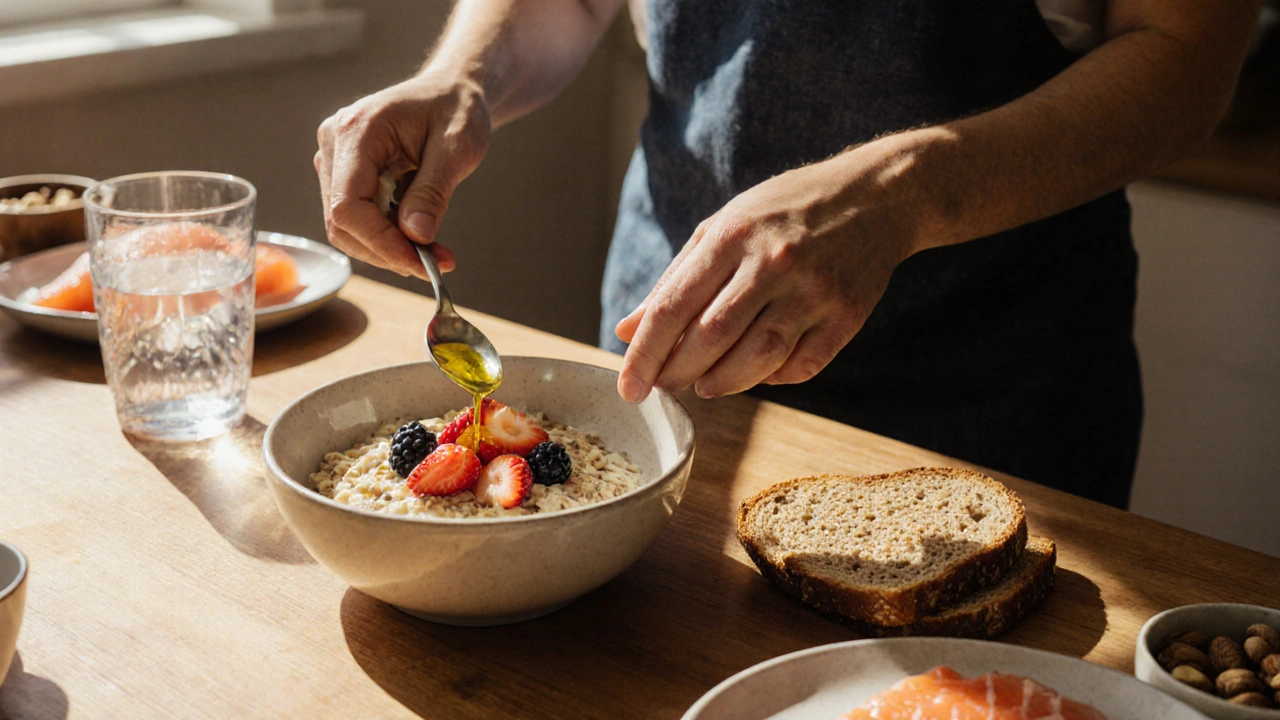Vascular Health Risk Calculator
This tool estimates your vascular health risk based on key factors discussed in the article. Your results will help you identify areas where lifestyle changes can make the biggest impact.
Your Vascular Health Risk Score
Personalized Recommendations
Living with vascular disease is a group of conditions that narrow or block your blood vessels, limiting blood flow to organs and tissues can feel overwhelming. The good news? Everyday choices around food, movement, and stress can dramatically slow progression and even improve symptoms. Below you’ll find practical steps you can start today, backed by current research and real‑world examples.
Key Takeaways
- Adopt a Mediterranean‑style diet rich in olive oil, nuts, and fish to lower inflammation.
- Aim for at least 150 minutes of moderate aerobic activity each week.
- Quit smoking - the benefits begin within days and continue for years.
- Maintain a healthy weight and control blood sugar to reduce vessel strain.
- Monitor blood pressure and cholesterol regularly; small improvements add up.
What is Vascular Disease?
When arteries or veins become narrowed, hardened, or clogged, the entire circulatory system suffers. The most common form is atherosclerosis, where plaque builds up on artery walls. Over time, plaque can restrict blood flow, leading to peripheral artery disease, coronary artery disease, or stroke. While genetics play a role, lifestyle factors are powerful modifiers.
Major Risk Factors You Can Influence
Understanding the drivers helps you target them effectively.
- Hypertension - high blood pressure damages vessel walls, accelerating plaque formation.
- High cholesterol - excess low‑density lipoprotein (LDL) fuels plaque growth.
- Smoking - chemicals cause inflammation and reduce oxygen delivery.
- Diabetes - high glucose levels damage the inner lining of vessels.
- Obesity and sedentary habits - excess weight raises blood pressure and worsens insulin resistance.
Dietary Strategies That Work
Food is medicine, especially for vascular disease. Below is a quick‑look comparison of three evidence‑based eating patterns.
| Diet | Core Foods | Key Vascular Benefits | Typical LDL Reduction |
|---|---|---|---|
| Mediterranean | Olive oil, fatty fish, nuts, fruits, vegetables, whole grains | Anti‑inflammatory fatty acids, high fiber, polyphenols | 10‑15% |
| DASH | Low‑fat dairy, lean protein, plenty of potassium‑rich veg, limited sodium | Reduces blood pressure, improves endothelial function | 5‑10% |
| Low‑Fat (<30% calories from fat) | Whole grains, legumes, low‑fat dairy, minimal added oils | Lower total calorie intake, modest cholesterol drop | 5‑8% |
Pick one that fits your tastes and stick with it for at least three months before judging results. Add these simple swaps:
- Replace butter with extra‑virgin olive oil on salads and vegetables.
- Snack on a handful of almonds or walnuts instead of chips.
- Include two servings of fatty fish (salmon, mackerel) weekly.
- Choose whole‑grain breads and pastas over refined versions.

Move More: Exercise Essentials
Physical activity improves blood flow, lowers blood pressure, and raises “good” HDL cholesterol. Aim for a mix of aerobic and resistance work.
- Start with brisk walking or cycling 20‑30 minutes, 3‑5 days a week.
- Progress to moderate intensity (you can talk but not sing) for 150 minutes per month.
- Include strength training (bodyweight squats, resistance bands) twice weekly to maintain muscle mass.
- If you have peripheral artery disease, consider a supervised walking program - walking until mild pain, resting, then repeating improves collateral circulation.
Consistency beats intensity. Even short “exercise snacks” - 5‑minute stair climbs throughout the day - add up.
Quit Smoking: A Non‑Negotiable Step
Smoking is the single biggest preventable cause of vascular damage. Benefits begin within 20 minutes (blood pressure drops) and peak after a year (circulation improves). Strategies that work:
- Use nicotine replacement (gum, patches) combined with behavioral support.
- Enroll in a quit‑line or local cessation program - many are free.
- Identify triggers (stress, coffee) and replace them with healthier habits (deep breathing, water).
- Reward yourself for milestones - a new book after one month smoke‑free, for example.
Weight Management and Blood Sugar Control
Excess weight inflates blood pressure and worsens insulin resistance, both of which strain vessels. Target a realistic 5‑10% weight loss.
- Track meals with a simple app or journal - awareness alone often cuts calories.
- Focus on protein and fiber at each meal to stay full longer.
- If you have diabetes, aim for an A1C below 7% as advised by your doctor.
- Stay hydrated; sometimes thirst masquerades as hunger.
Stress, Sleep, and Overall Well‑Being
Chronic stress releases cortisol, which can raise blood pressure and encourage unhealthy eating. Poor sleep (under 6hours) impairs endothelial function.
- Practice 5‑minute mindfulness breathing each morning.
- Schedule a regular “digital sunset” - no screens an hour before bed.
- Create a cool, dark sleep environment; aim for 7‑8 hours of uninterrupted rest.
- Engage in hobbies you love - gardening, music, or a weekly walk with a friend.

Monitoring Progress and Staying on Track
Regular check‑ups keep you accountable and catch issues early.
- Check blood pressure at home weekly; aim for < 130/80mmHg.
- Get a lipid panel at least once a year; target LDL < 100mg/dL (or <70mg/dL if high risk).
- Record weight and waist circumference each month.
- Discuss any new symptoms (leg pain, shortness of breath) with your clinician promptly.
Use a simple spreadsheet or a health‑tracking app to visualize trends.
Practical Checklist for Daily Success
- Eat a Mediterranean‑style breakfast: oatmeal topped with berries and a drizzle of olive oil.
- Walk or bike for 30minutes before or after work.
- Keep a pack of nicotine‑free gum handy for cravings.
- Log meals and activity before bedtime.
- Take prescribed meds at the same time each day - consistency matters.
Common Pitfalls and How to Avoid Them
Even motivated people stumble. Here’s what to watch for:
- All‑or‑nothing mindset: Missing one workout doesn’t erase progress. Reset and move on.
- Relying on “quick‑fix” diets: They often cut calories but lack nutrients needed for vessel repair.
- Skipping regular measurements: Without data you can’t see improvement.
- Social pressure to smoke or over‑eat: Have a prepared response or bring a healthy snack.
Next Steps: Personalize Your Plan
Take a moment to assess which area needs the biggest change. Write down one specific goal for the next week - whether it’s adding a 15‑minute walk after dinner or swapping butter for olive oil in one meal. Share your goal with a friend or family member; accountability boosts success.
Frequently Asked Questions
Can lifestyle changes reverse existing plaque?
Full reversal is rare, but studies show that a Mediterranean diet combined with regular exercise can stabilize plaques, reduce their size modestly, and lower the risk of rupture. Even a 5‑10% reduction in plaque volume translates to better blood flow and fewer symptoms.
How quickly can I see blood pressure improvements after quitting smoking?
Within 24‑48hours, heart rate and blood pressure begin to drop. Most former smokers notice a measurable reduction (5‑10mmHg) within a month, with continued decline over the first year.
Is it safe to start a vigorous exercise program if I have peripheral artery disease?
Start low‑impact activities like walking or stationary cycling under medical guidance. A supervised walking program, where you walk until mild leg pain then rest, is proven to improve circulation without over‑straining the legs.
Do I need to take supplements for heart health?
Most benefits come from whole foods. However, omega‑3 fish oil (1g daily) and a modest vitaminD supplement may help if your diet is low in fatty fish or you have limited sun exposure. Always discuss supplements with your doctor.
How often should I get a lipid panel?
If you’re on medication or have high risk factors, every 3‑6months. Otherwise, an annual test is sufficient to track changes from diet and exercise.


Samantha Gavrin
October 12, 2025 AT 15:15Ever notice how the “Mediterranean diet” hype aligns perfectly with the interests of multinational oil corporations? They’ve quietly funded research that glorifies olive oil while downplaying the risks of saturated fats. Meanwhile, the same labs push low‑fat, high‑carb products that keep us dependent on processed foods. It’s not a coincidence that the guidelines keep shifting toward what benefits the big players. If you look at the funding trails, the pattern is clear: profit drives the narrative, not pure science. So before you jump on the plate of extra virgin olive oil, ask who’s really cashing in on your health choices.
Stay skeptical and read the source papers yourself.
NIck Brown
October 20, 2025 AT 08:24Listen up, if you think tossing a salad once a week is going to fix a heart that’s been under siege for years, you’re dreaming. Real progress comes from disciplined routine, not occasional “healthy” moments. You need to commit to at least 150 minutes of moderate cardio, plus strength work to keep those vessels supple. Cut the processed snacks that scream “convenient” but whisper “danger” to your arteries. Remember, the body rewards consistency, not hype.
Andy McCullough
October 28, 2025 AT 01:32The pathophysiology of atherosclerotic plaque formation is intricately mediated by endothelial shear stress alterations.
When laminar flow is disrupted, nitric oxide bioavailability diminishes, precipitating inflammatory cascades.
This endothelial dysfunction upregulates VCAM‑1 and ICAM‑1 expression, fostering monocyte adhesion.
Subsequently, LDL particles infiltrate the intima, become oxidized, and are engulfed by macrophages forming foam cells.
Foam cells coalesce into fatty streaks, the precursor lesions of clinically relevant atheroma.
Hyperlipidemia accelerates this process by augmenting the particle pool of atherogenic LDL.
Statin therapy, by inhibiting HMG‑CoA reductase, reduces hepatic cholesterol synthesis and upregulates LDL receptors, thereby lowering circulating LDL concentrations.
However, pharmacotherapy alone cannot reverse pre‑existing calcific deposits without adjunctive lifestyle modification.
Aerobic exercise enhances endothelial progenitor cell mobilization, which contributes to re‑endothelialization of damaged segments.
Moreover, regular physical activity improves insulin sensitivity, mitigating hyperglycemic insults that exacerbate glycation end‑products in vascular walls.
Dietary patterns rich in polyunsaturated omega‑3 fatty acids exert anti‑inflammatory effects via resolvin and protectin pathways.
The Mediterranean paradigm, with its high monounsaturated fat content, also modulates lipid profiles by decreasing ApoB‑containing particles.
Sodium restriction attenuates extracellular fluid volume expansion, thereby reducing systolic afterload and arterial wall stress.
Smoking cessation eliminates the oxidative burden imposed by carbon monoxide and nicotine, allowing endogenous antioxidant systems to recover.
Integrating these behavioral interventions creates a synergistic milieu that decelerates plaque progression and may even induce regression in early lesions.
Therefore, a holistic regimen encompassing pharmacologic, nutritional, and kinetic components constitutes the evidence‑based cornerstone for vascular disease mitigation.
Zackery Brinkley
November 4, 2025 AT 18:41That’s a solid breakdown, especially the bit about endothelial progenitor cells. It’s encouraging to see how exercise can actually help repair vessels, not just burn calories. Keep it simple – a brisk walk, a bike ride, anything that gets the blood moving.
Patrick Fithen
November 12, 2025 AT 11:49We look at food not just as fuel but as a cultural script that carries meaning across generations the way we share olive oil is a ritual the same way spice markets tell stories of trade and migration every bite connects us to a lineage of survival and adaptation the heart listens to these stories through the vessels that pump life it is poetic how a simple salad can echo ancient agrarian practices and modern science together they remind us that health is a narrative we write with every meal
Michael Leaño
November 20, 2025 AT 04:58Wow, that perspective really puts the diet into a larger picture! It’s amazing how something as everyday as a bowl of greens can feel like a link to history. Keep seeing your meals as chapters; you’ll stay motivated to choose the healthiest ones.
Anirban Banerjee
November 27, 2025 AT 22:06Dear reader, it is imperative to recognize that adherence to evidence‑based nutritional guidelines must be complemented by regular clinical assessments. One should schedule periodic lipid panels and blood pressure measurements to monitor therapeutic progress. Moreover, incorporating a structured aerobic regimen, as advised by cardiology societies, enhances endothelial function. I encourage you to engage with a multidisciplinary team to tailor interventions to your individual risk profile.
Mansi Mehra
December 5, 2025 AT 15:15The preceding commentary, while thorough, contains several typographical inconsistencies that detract from its professionalism. Additionally, the use of colloquial expressions undermines the academic tone expected in such discussions. A more disciplined approach to syntax and diction would substantially improve clarity. I recommend revising the manuscript to conform to standard scholarly conventions.